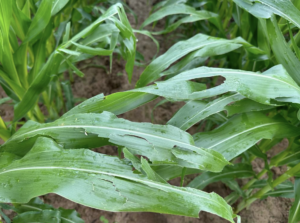Rain makes grain. Those words are as old as farming itself. In the nation’s breadbasket – the three I states, which produce 42% of our corn and 37% of our soybeans – there’s concern over the lack of rain. That triggered a major movement in the grain market. Drought officially grips 100% of the I states. When I was visiting my family farm in western Illinois two weeks ago, corn leaves were already rolling as a defense mechanism to conserve moisture. They have not received any rain since. The corn continues to grow, but it has been affected, as during these past few weeks ear size is being determined. Less than half of the corn in Illinois is rated good-excellent. Soybean leaves are puckering in many areas. Over three-quarters of the topsoil in Ohio, Wisconsin and Michigan is rated as short to very short. Corn markets were up 25 cents on Friday, soybeans jumped 50 cents. But domestic weather isn’t the only factor pushing soybeans, which have already climbed $1.65 this month. The US dollar now stands at a one-year low against Brazilian currency. Why does this matter? Brazil is the USA’s biggest competitor on the world export stage. With two-thirds of American soybeans exported, a weaker dollar makes US soybeans even more attractive.
Dry conditions have caused cover crop woes throughout the Midwest. As cover crop popularity grows, it’s understandable that many farmers new to the practice are experiencing challenges. Even seasoned pros will tell you the practice takes lots of refinement. Cereal rye is a popular cover crop. That’s because it is fairly easy to grow, has a vast fibrous root system to hold topsoil in place and once terminated provides an excellent mulch to choke out weeds. Plus, rye can be planted late in the fall. Unlike growers in the South, those in the upper Midwest have a very short window to plant cover crops, so cereal rye may represent the only viable option for some growers. The problem is, cereal rye is a grass, and so is corn. Growers in the north who “planted green” – planted corn directly into rye without killing it first – have seen competition for moisture and nutrients. Some are attributing the rye to poor corn growth due to lack of moisture. Cover crop termination strategies are always critical and amplified in years of low moisture. Let’s hope new cover crop growers won’t give up on the practice.
My corn is growing rapidly, now at the V8 growth stage, with some plants reaching head high on my 6’3” frame. Check out the color: a beautiful dark green. And the stalks are very stout. The leaves are giant solar panels. We’ve had over 3” of rain in the past 10 days, which has led to the plants growing inches per day. As of Friday morning, my head-high-in-six-weeks corn was among the best I had ever seen, much less grown.
Mother Nature can be as cruel as she is kind. And it can seemingly happen in an instant. Late Friday afternoon a sudden hail storm hit my corn. Leaves were shotgunned, ripped and shredded. A seed salesman friend told me he’s never seen more hail damage in the Delta than the past couple of weeks. So, are the plants as bad as they look? Time will tell. Fortunately, based on my scouting, there was no damage to the whorls or stalks. So, the growing point, which is now above ground, is still fully intact. According to Iowa State University, “A reduction in leaf area of less than 50% does not reduce yield if it occurs before V13.” That’s encouraging. Other studies indicate that even when all the leaves below the ear are removed, there is little to no yield loss. And to further ease my mind, no less of a source than my mother (I mean, she has been involved in farming for over 60 years) thinks the corn will be fine.
It’s #NationalPollinatorWeek! Not only do pollinators keep the world beautiful, they also keep us fed. Three-quarters of all flowering plants and 35% of all food crops rely on bees, butterflies and other pollinators to reproduce. From apples to zucchini, that’s one out of every three bites of food you eat. Natural Huma® products are pollinator friendly and work in tandem with regen ag systems to support Mother Nature’s ecosystem.
Related Posts

BIO ENERGIZER® Reduces Sludge 45% In One Year, Saves Municipal Plant $6 Million In Dredging Costs
by Heather Jennings, PS In this study, a one-year bioremediation plan featuring Bio Energizer® was implemented for a municipal wastewater treatment facility with 2 primary lagoons in which sludge depths had reached 5–7 feet. The lagoons were at risk of upset and wastewater processing capacity was reduced. Bio Energizer® was added via peristaltic pump to

Water Master Plans
By Heather Jennings, PE When I worked with engineering firms, there were a lot of water master plans being developed. Many of them were updates, as the plans had been around for 5–10 years and needed revision. Some master plans evaluated water and wastewater systems from scratch. All of these were interesting to me due

EARTH DAY 2020: Celebrating 50 Years
Fifty years ago today, on April 22, 1970, 20 million Americans took to the streets to protest environmental destruction and to celebrate the wonders of Planet Earth. The basic message was that we had to find new ways to live our lives, raise our food, and conduct our businesses that were environmentally friendly and sustainable—that






